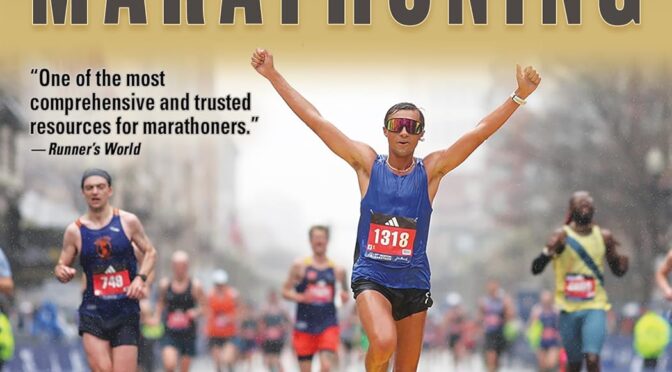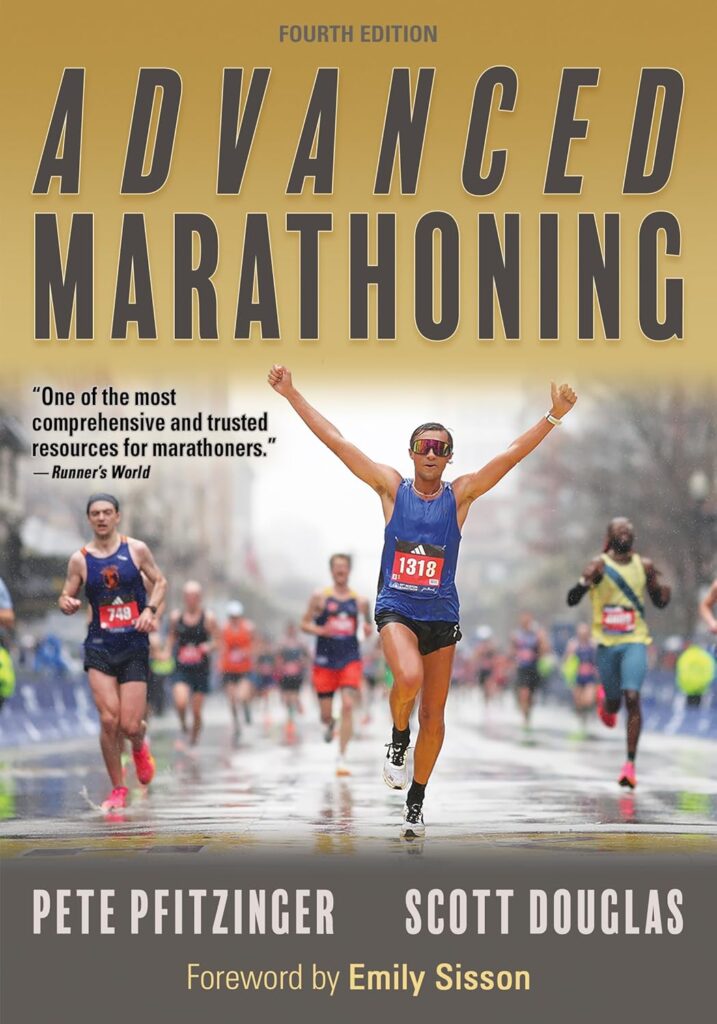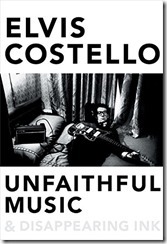This is a new edition of a book well-known in the running community as among the best available guides to marathon training. The first edition was published in 2001, the second in 2008, and the third in 2019.
That third edition is personally important to me. When I was contemplating running a marathon for the first time, my son gave me the book based on recommendations from the Reddit Advanced Running group. I have read the book multiple times and followed its 18/55 schedule twice, on both occasions achieving my target time, and qualifying for a “good for age” place for the London marathon next year. I regard the book as a key factor in that success.
The new edition follows the same proven structure as its predecessor but with a modernised design, colour photographs (previously all were monochrome), updated elite runner biographies, and updated text and schedules based on the latest research and feedback from readers.
The book is aimed at runners who want not only to run the marathon, but to achieve a good performance. “The runners for whom we wrote this book have goals such as setting a personal best, qualifying for Boston, or running faster than they did 10 years ago,” the authors state.
That does not mean you have to be an elite runner. The schedules (training plans) here are relatively demanding, and therefore require commitment, but the pace you choose as your target for the marathon is up to you. When I first picked up the book I observed that a table in the first chapter (and the same in this edition) lists marathon goal paces from 5:00/mile (3:06/km) to 8:30/mile (5:17/km). Although it is not explicitly stated, this seems a reasonable guide to the range of speeds the authors anticipate, though the book is a good read for anyone who wants to understand marathon training better.
If you expect to complete the marathon in over 4 hours (slower than 9:09/mile or 5:41/km) then the schedules here are likely less suitable for you since the suggested distances may take too long, though the new edition is a little more flexible in this respect.
How to train for a marathon
Training for a marathon is not just about following a schedule. It helps to understand the basics of how to train, as well as other key components such as nutrition and core strength training. There is also the detail of how to run a workout, and what to do when something does not work out because of injury or life getting in the way.
Part 1 of this book is called training components and has the following chapters:
Elements of training: a short but informative summary of what we know about how to train for endurance running. Not much changed in this edition. It’s an excellent simplified guide. If you want to know more try The Science of Running by Steve Magness.
Nutrition and hydration: this is an important and somewhat contentious topic with updates in this edition to increase the suggested amount of carbohydrates you should consume during a run. Some good practical tips on things like how to drink on the run.
Balancing training and recovery: the title of the chapter says it all, training is all about the body adapting to the stress you put on it, and that adaption takes place when you are recovering so this balance is critical. A few changes in this edition such as a discussion of super shoes.
Supplementary training: something I did not know before taking up running is that simply running is not enough to strengthen your muscles for optimum performance. Additional core strength training will make you faster as well as probably reducing injury risk. Quite a few changes in this edition with some different exercises, clearer instructions and new photos. It looks to me as if the new edition has been carefully revised to reflect research in this important area. Do not neglect this; it is a key part of the training.
Advanced marathoning for masters runners: this is interesting to me as I am in this category, but it is not my favourite chapter, partly because it is dispiriting to read about our slower pace and greater injury risk as we age. Another thing is that the older runners in the examples are not that old by some standards, Kate Landau and Roberta Groner in their 40s for example. In the first edition Douglas wrote about running in his 50s; that has been rewritten now as a runner in his 60s which is closer to home for me.
Tapering for peak marathon performance: a great short chapter on a suprisingly complex topic and one for which data is inconclusive. The idea is to get to the start line in peak condition which means reducing workouts enough to remove fatigue, but not so much that you begin to detrain.
Race day strategy: I love this pragmatic chapter about the day itself, how to pace yourself, when to consider dropping out, coping with the psychology of the race and more. Pure gold, not much changed in this edition.
Training schedules
Part 2 of the book contains the training schedules and how to use them. There are a range, based on how long you have to train (18 weeks or 12 weeks) and how many miles per week you can manage (up to 55, 55-70, 70-85, more than 85).
Research shows that higher weekly mileage corresponds well, for most runners, with faster marathon times and lower risk of a severe drop in pace over the last 6 miles. Higher mileage is also more demanding and not to be taken lightly. Personally I have not gone beyond the “up to 55” schedules.
The authors define several types of training runs, these being long runs, medium-long runs (typically run midweek), marathon pace (MP) runs, lactate threshold (LT) runs (faster than MP), general aerobic runs (moderate effort), recovery runs (short easy runs), VO2Max intervals, and speed training (sprints or strides).
That is a lot of variety and the key chapter here is called Following the schedules; I have read it carefully several times! Note that the schedules do not show actual paces but you are guided either by calculating the pace from your MP or by using heart rate; I have chosen the MP approach.
A change in this edition is that the runs are more flexible. For example, the LT runs can now be done as intervals rather than as warm up, LT run, cool down. There is also a little more give in the schedules, such as a run of 8-9 miles instead of simply 9 miles. These changes are mainly aimed at slower runners giving them permission to run a little shorter, though if you always run the maximum distance you would actually run a little further than in the third edition schedules.
There are also schedules for recovery after the marathon, and a chapter on multiple marathons where you want a good time twice over a short period such as 4 or 6 weeks.
I was sorry to see that one of my favourite sections in the multiple marathoning chapter has been removed in this edition. This was called Why multiple marathoning and included the comment, “normal marathoners should check the amount of glass in their houses before throwing stones at multiple marathoners. After all, the bulk of this book has been devoted to detailing how to maximize your chances of success at an activity that the human body isn’t really suited for.”
Space reasons? Too close to the bone? Not sure but I will keep my third edition on the shelf.
The book for you?
This book has worked for me and I recommend it provided that you have the time and commitment for the schedules and with the caveat that it is likely less suitable for those who expect to take over 4 hours.
In general the training here is old-school and not in tune with the current trend towards more low intensity running such as the Norwegian Singles approach. I do not thing there is any consensus on the best approach and every runner is an unique human being so it is hard to declare any particular type of program as best.
My observation though from anecdotal data such as Reddit run reports is that those who follow the schedules in this book, commonly called just “Pfitz”, tend to get good times and avoid common pitfalls like having to walk the last few miles, though not exclusively so. However that could also reflect the fact that the schedules represent a significant commitment, more than many other plans.
Another often recommended book is Daniel’s Running Formula by Jack Daniels. I have this one too and my observation is that Daniels describes the system he devised whereas Advanced Marathoning is a more general approach. Working out how to follow the schedules in the Daniels book is more complex and there is a little less pragmatic advice, though Daniels does have a chapter on treadmill training which Pfitzinger and Douglas hardly mentions. I am sure that excellent results are possible with either book.
Is the book worth it if you have the third edition? The earlier book is not suddenly less good than it was, but things like the revised supplementary training and more flexible schedules are worth having, and the modern design and new elite runner anecdotes are nice to have. It is, after all, a small expense compared to the cost of your running shoes.
Finally, one thing I like about Advanced Marathoning is the concise, pithy writing. There are little comments which I come back to again and again, even while actually running a race. For example, the authors describe the final 6 miles of the marathon, often the most difficult, as “the most rewarding stage of the marathon … this is the stretch that poorly prepared marathoners fear and well-prepared marathoners relish.”
Whether or not you read this book, I hope this is true for you.
Disclosure: if you buy the book from an Amazon link on this page I will get a small commission








